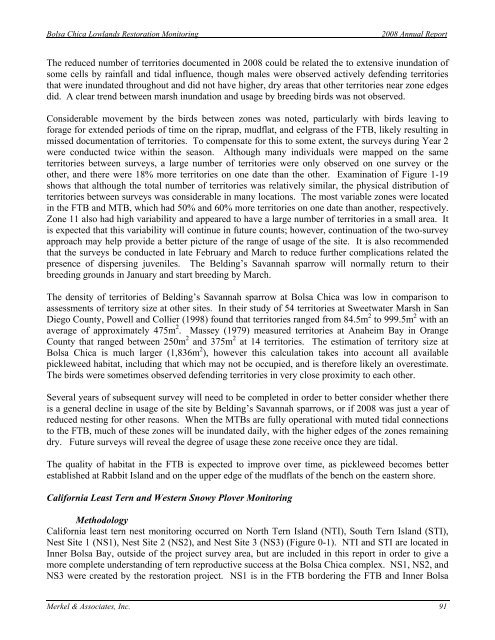2008 Annual Monitoring Report (pdf 10.9MB) - Bolsa Chica ...
2008 Annual Monitoring Report (pdf 10.9MB) - Bolsa Chica ...
2008 Annual Monitoring Report (pdf 10.9MB) - Bolsa Chica ...
Create successful ePaper yourself
Turn your PDF publications into a flip-book with our unique Google optimized e-Paper software.
<strong>Bolsa</strong> <strong>Chica</strong> Lowlands Restoration <strong>Monitoring</strong><br />
<strong>2008</strong> <strong>Annual</strong> <strong>Report</strong><br />
The reduced number of territories documented in <strong>2008</strong> could be related the to extensive inundation of<br />
some cells by rainfall and tidal influence, though males were observed actively defending territories<br />
that were inundated throughout and did not have higher, dry areas that other territories near zone edges<br />
did. A clear trend between marsh inundation and usage by breeding birds was not observed.<br />
Considerable movement by the birds between zones was noted, particularly with birds leaving to<br />
forage for extended periods of time on the riprap, mudflat, and eelgrass of the FTB, likely resulting in<br />
missed documentation of territories. To compensate for this to some extent, the surveys during Year 2<br />
were conducted twice within the season. Although many individuals were mapped on the same<br />
territories between surveys, a large number of territories were only observed on one survey or the<br />
other, and there were 18% more territories on one date than the other. Examination of Figure 1-19<br />
shows that although the total number of territories was relatively similar, the physical distribution of<br />
territories between surveys was considerable in many locations. The most variable zones were located<br />
in the FTB and MTB, which had 50% and 60% more territories on one date than another, respectively.<br />
Zone 11 also had high variability and appeared to have a large number of territories in a small area. It<br />
is expected that this variability will continue in future counts; however, continuation of the two-survey<br />
approach may help provide a better picture of the range of usage of the site. It is also recommended<br />
that the surveys be conducted in late February and March to reduce further complications related the<br />
presence of dispersing juveniles. The Belding’s Savannah sparrow will normally return to their<br />
breeding grounds in January and start breeding by March.<br />
The density of territories of Belding’s Savannah sparrow at <strong>Bolsa</strong> <strong>Chica</strong> was low in comparison to<br />
assessments of territory size at other sites. In their study of 54 territories at Sweetwater Marsh in San<br />
Diego County, Powell and Collier (1998) found that territories ranged from 84.5m 2 to 999.5m 2 with an<br />
average of approximately 475m 2 . Massey (1979) measured territories at Anaheim Bay in Orange<br />
County that ranged between 250m 2 and 375m 2 at 14 territories. The estimation of territory size at<br />
<strong>Bolsa</strong> <strong>Chica</strong> is much larger (1,836m 2 ), however this calculation takes into account all available<br />
pickleweed habitat, including that which may not be occupied, and is therefore likely an overestimate.<br />
The birds were sometimes observed defending territories in very close proximity to each other.<br />
Several years of subsequent survey will need to be completed in order to better consider whether there<br />
is a general decline in usage of the site by Belding’s Savannah sparrows, or if <strong>2008</strong> was just a year of<br />
reduced nesting for other reasons. When the MTBs are fully operational with muted tidal connections<br />
to the FTB, much of these zones will be inundated daily, with the higher edges of the zones remaining<br />
dry. Future surveys will reveal the degree of usage these zone receive once they are tidal.<br />
The quality of habitat in the FTB is expected to improve over time, as pickleweed becomes better<br />
established at Rabbit Island and on the upper edge of the mudflats of the bench on the eastern shore.<br />
California Least Tern and Western Snowy Plover <strong>Monitoring</strong><br />
Methodology<br />
California least tern nest monitoring occurred on North Tern Island (NTI), South Tern Island (STI),<br />
Nest Site 1 (NS1), Nest Site 2 (NS2), and Nest Site 3 (NS3) (Figure 0-1). NTI and STI are located in<br />
Inner <strong>Bolsa</strong> Bay, outside of the project survey area, but are included in this report in order to give a<br />
more complete understanding of tern reproductive success at the <strong>Bolsa</strong> <strong>Chica</strong> complex. NS1, NS2, and<br />
NS3 were created by the restoration project. NS1 is in the FTB bordering the FTB and Inner <strong>Bolsa</strong><br />
Merkel & Associates, Inc. 91






